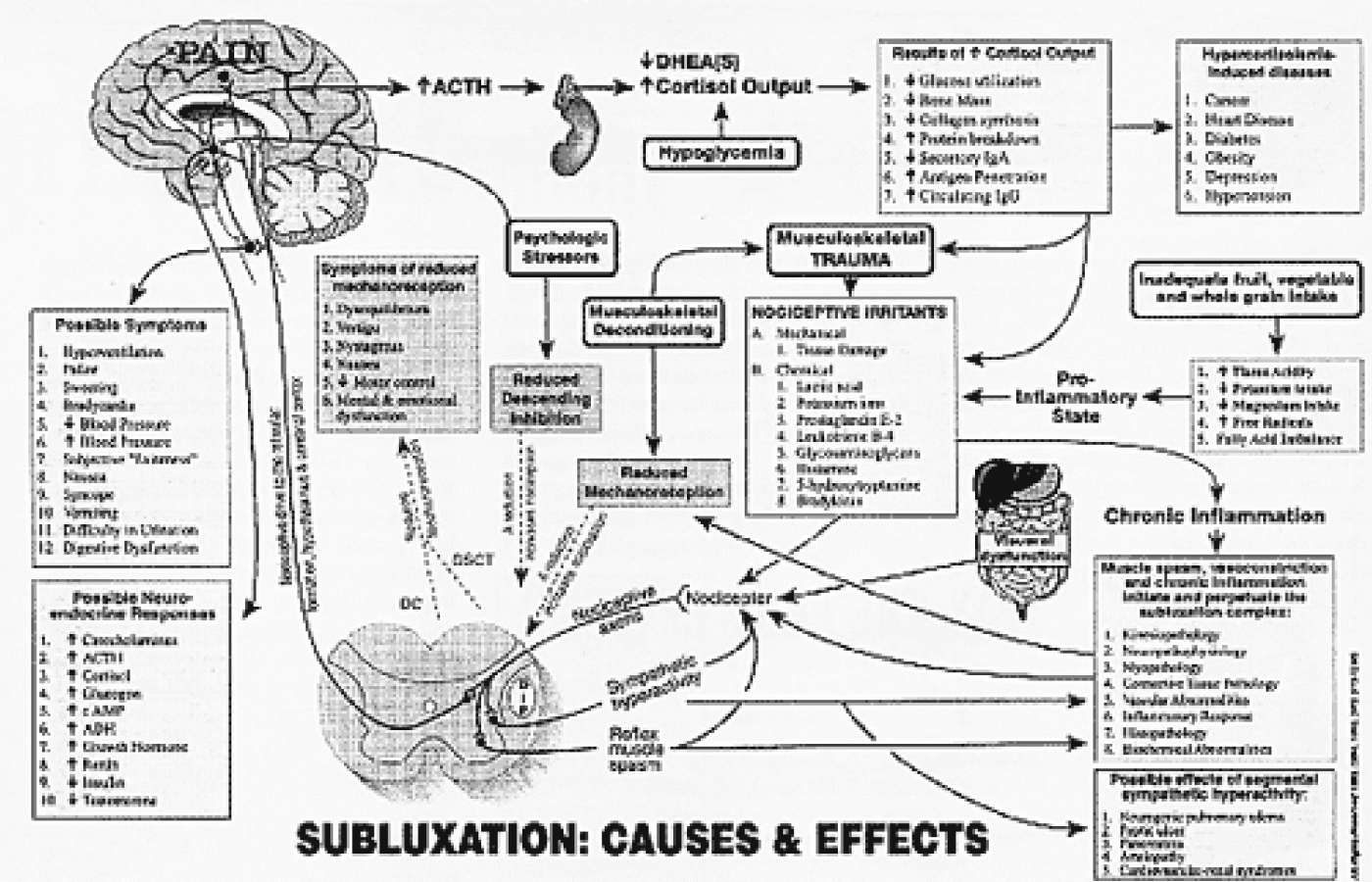Some doctors thrive in a personality-based clinic and have a loyal following no matter what services or equipment they offer, but for most chiropractic offices who are trying to grow and expand, new equipment purchases help us stay relevant and continue to service our client base in the best, most up-to-date manner possible. So, regarding equipment purchasing: should you lease, get a bank loan, or pay cash?
Subluxation: Causes and Effects
Where is the Neurological Connection in Subluxation?
Our profession has always maintained that subluxations can influence nervous system function. A look at the definitions provided by the Mercy Guidelines and those of the Wyndham Guidelines is revealing.
Mercy Guidelines
Subluxation Complex:32 An aberration of normal spinal biomechanics, usually involving a restriction or loss of normal movement of a motion segment, and associated aberrations in the tissues which support articular motion (e.g., nerve, muscle, connective tissue and vascular).
Subluxation Syndrome:32 The clinical signs and symptoms thought to relate to pathophysiology or dysfunction of spinal motion segments or to peripheral joints that may be amenable to manipulative/adjustive procedures.
Wyndham Guidelines
Subluxation Complex:41 A misalignment of one or more articulations of the spinal column or its immediate weight-bearing articulations, to a degree less than a luxation, which by inference causes alteration of nerve function and interference to the transmission of mental impulses, resulting in a lessening of the body's innate ability to express its maximum health potential.
As all readers can see, these three definitions do not discuss a relationship between subluxation and the nervous system. Unfortunately, the majority of DCs accept these or similar definitions of subluxation. Yes, we actually accept definitions of subluxation that exclude the nervous system.
To better relate the nervous system to spinal function, I generated the following definition of subluxation:14
The Subluxation Complex
- A kinesiopathogical joint lesion (usually hypomobility) that develops as a consequence of: 1) micro and/or macrotraumatic tissue injury and the associated inflammatory response; 2) inflammatory damage that may be perpetuated by a nutritional status that is pro-inflammatory in nature; 3) degenerative changes in muscular and connective tissues due to sedentary living; 4) decreased descending inhibitory pathway activity due to aberrant psychological states; and 5) dysafferentation (i.e., increased nociception and decreased mechanoreception which can be caused by 1-4).
- Evaluation of hypomobile joints consistently reveals histopathological changes within the associated neuromusculoskeletal tissues, which demonstrates that a hypomobile joint manifests as a structural disease that chiropractors call the subluxation complex.
- This disease called the subluxation complex, may produce a variety of patient-specific symptoms depending upon specific end organ changes initiated by nociceptive reflex activity, and which central autonomic, endocrine, limbic, motor and/or sensory nuclei are most affected by dysafferent input, i.e., increased nociception and decreased mechanoreception.

This definition can be visualized in the diagram "Subluxation: Causes and Effects." The neurological components of both the definition and diagram were generated from a number of papers devoted to the topics of nociception, inflammation, pain, and mechanoreception. Consider what the experts have determined:
- Tissue injury results in the release of chemical mediators of inflammation and nociception.24
- Nociceptive input can cause pain, muscle spasm, and vasoconstriction.4
- Muscle spasm and pain can both promote joint hypomobility. In immobilization studies, it was demonstrated that the early stages of joint hypomobility was due almost exclusively to the muscle/tendon component. Now a vicious circle can develop. Muscle spasm is known to irritate nociceptors directly, and the spasm can compress muscular blood vessels and cause ischemia, which leads to the release of chemical mediators of inflammation and nociception20 (p.128). Both the mechanical and chemical irritation of nociceptors can perpetuate pain, spasm, and vasoconstriction.
The experience of pain itself can cause us to consciously reduce joint mobility.30 Our general mental state concerning pain tells us, "If it hurts to move, don't move."
It is known that immobilization can lead to deconditioning of joints, ligaments, discs, bone and muscle.28,30,34. Both the physiologically-induced, i.e., muscle spasm, and the mentally-induced immobility can lead to the development of the so-called deconditioning syndrome. Of course, we chiropractors refer to these pathological changes in the spinal column as the subluxation complex.
- Visceral dysfunction can irritate nociceptors and add to the nociceptive drive to the cord.4,9,10
- Joint hypomobility, muscle spasm, and inflammation can enhance nociception and reduce mechanoreception.23
- Reduced mechanoreception enhances nociception.23,37
- Negative mental attitudes reduce descending inhibition, which may enhance nociception.18,31,36,42
- Musculoskeletal deconditioning reduces mechanoreception.29
- Nociceptor sensitization, reduced mechanoreception, and reduced descending inhibition can all increase the excitability of the nervous system.1,15,43
- Nociceptive input can promote segmental sympathetic hyperactivity which may promote visceral dysfunction.4,27
- It is known that ascending nociceptive impulses can stimulate the hypothalamus and brain stem centers, which can produce a variety of symptoms.5,17,33,44
- Reduced mechanoreception may impair vestibular, cerebellar and cerebral function.6,11,19,20,22
- Reduced mechanoreception may cause autonomic dysfunction within the brain stem and promote a variety symptoms.6 (p. 225),7
- Nociceptive input is known to cause a variety of neuroendocrine responses.5,44
- Fear, anxiety and apprehension can act as psychologic stressors and stimulate cortisol release.5
- Hypoglycemia can cause cortisol release.2
- Elevated levels of free cortisol can alter numerous metabolic processes.2,12
- Hypercortisolemia is thought to play a pathogenic role in many diseases.13 Reduced DHEA(S) levels are known to promote similar diseases.12,13
- An inadequate consumption of fruits, vegetables and whole grains can promote a pro-inflammatory state.3,8,16,21,25,26,35,38,39,40
With all of this information in mind, closely examine the diagram in this article. Each of the pathways and correlations is known to exist. It does indeed appear that subluxation and many symptoms can be caused, in part, by enhanced nociception and reduced mechanoreception. I refer to this abnormal afferent input as dysafferentation and propose that it is a neurological cause and effect of subluxation.
Author's note: The topics in this article will be discussed in great detail in MPI's Neurology Diplomate program.
For a list of references for this article, please call (800)377-7978.
David Seaman, DC, MS, DABCN
Hendersonville, North Carolina



